The Effect of Inorganic Nitrogen Fertilizers on the Quality of Forage Composed of Various Species of Legumes in the Northern Part of a Temperate Climate Zone
Abstract
:1. Introduction
2. Results
2.1. Crude Protein
2.2. Modified Acid Detergent Fiber
2.3. Neutral Acid Detergent Fiber
2.4. Water-Soluble Carbohydrates
2.5. Dry Matter Digestibility
3. Discussion
4. Materials and Methods
4.1. Experimental Site
4.2. Weather Conditions
4.3. Experimental Design
4.4. Plant Sampling and Measurements
4.5. Statistical Analysis
Author Contributions
Funding
Data Availability Statement
Conflicts of Interest
References
- Segura, C.; Cardenas, L.; McDowell, R.; Morgan, S.; Blackwell, M.S.A. Effects on soil of grassland management for pasture, hay and silage. Ref. Modul. Earth Syst. Environ. Sci. 2023, 3, 102–112. [Google Scholar] [CrossRef]
- Gao, H.; Tian, H.; Zhang, Z.; Xia, X. Warming-induced greenhouse gas fluxes from global croplands modified by agricultural practices: A meta-analysis. Sci. Total Environ. 2022, 820, 153288. [Google Scholar] [CrossRef] [PubMed]
- Beillouin, D.; Schauberger, B.; Bastos, A.; Ciais, P.; Makowski, D. Impact of extreme weather conditions on European crop production in 2018: Random forest—Yield anomalies. Philos. Trans. R. Soc. B Biol. Sci. 2020, 375, 1810. [Google Scholar] [CrossRef] [PubMed]
- Lesk, C.; Rowhani, P.; Ramankutty, N. Influence of extreme weather disasters on global crop production. Nature 2016, 529, 84–87. [Google Scholar] [CrossRef]
- Weiby, K.V.; Krizsan, S.J.; Eknæs, M.; Schwarm, A.; Whist, A.C.; Schei, I.; Steinshamn, H.; Lund, P.; Beauchemin, K.A.; Dønnem, I. Associations among nutrient concentration, silage fermentation products, in vivo organic matter digestibility, rumen fermentation and in vitro methane yield in 78 grass silages. Anim. Feed. Sci. Technol. 2022, 285, 115249. [Google Scholar] [CrossRef]
- Sehgal, A.; Sita, K.; Siddique, K.H.M.; Kumar, R.; Bhogireddy, S.; Varshney, R.K.; HanumanthaRao, B.; Nair, R.M.; Prasad, P.V.V.; Nayyar, H. Drought or/and heat-stress effects on seed filling in food crops: Impacts on functional biochemistry, seed yields, and nutritional quality. Front. Plant Sci. 2018, 871, 1–19. [Google Scholar] [CrossRef]
- Powell, J.P.; Reinhard, S. Measuring the effects of extreme weather events on yields. Weather Clim. Extrem. 2015, 12, 69–79. [Google Scholar] [CrossRef]
- Lüscher, A.; Barkaoui, K.; Finn, J.A.; Suter, D.; Suter, M.; Volaire, F. Using plant diversity to reduce vulnerability and increase drought resilience of permanent and sown productive grasslands. Grass Forage Sci. 2022, 77, 235–246. [Google Scholar] [CrossRef]
- Dodd, R.J.; Chadwick, D.R.; Hill, P.W.; Hayes, F.; Sánchez-Rodríguez, A.R.; Gwynn-Jones, D.; Smart, S.M.; Jones, D.L. Resilience of ecosystem service delivery in grasslands in response to single and compound extreme weather events. Sci. Total Environ. 2023, 861, 160660. [Google Scholar] [CrossRef]
- Eurostat, 2020. Share of Main Land Types in Utilised Agricultural Area (UAA) by NUTS 2 Regions. Available online: https://ec.europa.eu/eurostat/web/agriculture/data/database (accessed on 15 June 2023).
- EuroStat, 2019. Permanent Grassland. Available online: https://ec.europa.eu/eurostat/statistics-explained/index.php?title=Glossary:Permanent_grassland (accessed on 15 June 2023).
- Chen, X.; Chen, H.Y.H.; Chen, C.; Ma, Z.; Searle, E.B.; Yu, Z.; Huang, Z. Effects of plant diversity on soil carbon in diverse ecosystems: A global meta-analysis. Biol. Rev. 2020, 95, 167–183. [Google Scholar] [CrossRef]
- Grange, G.; Finn, J.A.; Brophy, C. Plant diversity enhanced yield and mitigated drought impacts in intensively managed grassland communities. J. Appl. Ecol. 2021, 58, 1864–1875. [Google Scholar] [CrossRef]
- Grange, G.; Brophy, C.; Finn, J.A. Grassland legacy effects on yield of a follow-on crop in rotation strongly influenced by legume proportion and moderately by drought. Eur. J. Agron. 2022, 138, 126531. [Google Scholar] [CrossRef]
- Shamseldin, A. Future Outlook of Transferring Biological Nitrogen Fixation (BNF) to Cereals and Challenges to Retard Achieving this Dream. Curr. Microbiol. 2022, 79, 1–10. [Google Scholar] [CrossRef]
- McDonald, I.; Baral, R.; Min, D. Effects of alfalfa and alfalfa-grass mixtures with nitrogen fertilization on dry matter yield and forage nutritive value. J. Anim. Sci. Technol. 2021, 63, 305–318. [Google Scholar] [CrossRef] [PubMed]
- Sheaffer, C.C.; Peterson, M.A.; Mccalin, M. Acide Detergent Fiber, Neutral Detergent Fiber Concentration and Relative Feed Value. N. Am. Alfalfa 1995. Available online: http://www.naaic.org/stdtests/acidfiber.pdf (accessed on 1 July 2023).
- Ball, D.M.; Colins, M.; Lacefield, G.D.; Martin, N.P.; Mertens, D.A.; Olson, K.E.; Putnam, D.H.; Undersander, D.J.; Wolf, M.W. Understanding Forage Quality; American Farm Bureau Federation Publication: Park Ridge, IL, USA, 2001; Volume 1, p. 17. [Google Scholar]
- Bixby, J.N.; Bosch, A.J.; Elvehjem, C.A.; Swanson, A.M. Nutritive Value of Milk: Factors Affecting the Nutritive Value of Cow’s Milk. J. Agric. Food Chem. 1954, 2, 978–982. [Google Scholar] [CrossRef]
- Blaix, C.; Chabrerie, O.; Alard, D.; Catterou, M.; Diquelou, S.; Dutoit, T.; Lacoux, J.; Loucougaray, G.; Michelot-Antalik, A.; Pacé, M.; et al. Forage nutritive value shows synergies with plant diversity in a wide range of semi-natural grassland habitats. Agric. Ecosyst. Environ. 2023, 347, 108369. [Google Scholar] [CrossRef]
- Elgersma, A.; Søegaard, K. Effects of species diversity on seasonal variation in herbage yield and nutritive value of seven binary grass-legume mixtures and pure grass under cutting. Eur. J. Agron. 2016, 78, 73–83. [Google Scholar] [CrossRef]
- Raffrenato, E.; Fievisohn, R.; Cotanch, K.W.; Grant, R.J.; Chase, L.E.; Van Amburgh, M.E. Effect of lignin linkages with other plant cell wall components on in vitro and in vivo neutral detergent fiber digestibility and rate of digestion of grass forages. J. Dairy Sci. 2017, 100, 8119–8131. [Google Scholar] [CrossRef]
- Bo, P.T.; Dong, Y.; Zhang, R.; Htet, M.N.S.; Hai, J. Optimization of Alfalfa-Based Mixed Cropping with Winter Wheat and Ryegrass in Terms of Forage Yield and Quality Traits. Plants 2022, 11, 1752. [Google Scholar] [CrossRef]
- Atis, I.; Konuskan, O.; Duru, M.; Gozubenli, H.; Yilmaz, S. Effect of harvesting time on yield, composition and forage quality of some forage sorghum cultivars. Int. J. Agric. Biol. 2012, 14, 879–886. [Google Scholar]
- Katoch, R. Nutritional Quality Management of Forages in the Himalayan Region. In Nutritional Quality Management of Forages in the Himalayan Region; Springer: Singapore, 2022; pp. 1–590. [Google Scholar] [CrossRef]
- Kertz, A.F.; Hill, T.M.; Quigley, J.D.; Heinrichs, A.J.; Linn, J.G.; Drackley, J.K. A 100-Year Review: Calf nutrition and management. J. Dairy Sci. 2017, 100, 10151–10172. [Google Scholar] [CrossRef] [PubMed]
- Dindová, A.; Hakl, J.; Hrevušová, Z.; Nerušil, P. Relationships between long-term fertilization management and forage nutritive value in grasslands. Agric. Ecosyst. Environ. 2019, 279, 139–148. [Google Scholar] [CrossRef]
- Daniele, B.C.; Barbara, S.; Isabel, B.; Alberto, G. Analysis of perceived robustness, adaptability and transformability of Spanish extensive livestock farms under alternative challenging scenarios. Agric. Syst. 2022, 202, 103487. [Google Scholar] [CrossRef]
- Rehling, F.; Sandner, T.M.; Matthies, D. Biomass partitioning in response to intraspecific competition depends on nutrients and species characteristics: A study of 43 plant species. J. Ecol. 2021, 109, 2219–2233. [Google Scholar] [CrossRef]
- Zhao, J.; Zeng, Z.; He, X.; Chen, H.; Wang, K. Effects of monoculture and mixed culture of grass and legume forage species on soil microbial community structure under different levels of nitrogen fertilization. Eur. J. Soil. Biol. 2015, 68, 61–68. [Google Scholar] [CrossRef]
- Lüscher, A.; Mueller-Harvey, I.; Soussana, J.F.; Rees, R.M.; Peyraud, J.L. Potential of legume-based grassland-livestock systems in Europe: A review. Grass Forage Sci. 2014, 69, 206–228. [Google Scholar] [CrossRef]
- Schmidt, V.A.M.; Watson, C.A.; Walker, R.L.; Argo, C.M.; Russell, W.R.; Neacsu, M.; Harris, P.A.; Morrison, P.K. 50 Water-soluble carbohydrate content in equine pasture: Impact of fertilization, season, and grass species. J. Equine Vet. Sci. 2023, 124, 104352. [Google Scholar] [CrossRef]
- Thers, H.; Eriksen, J. Annual protein yield and extractable protein potentials in three legumes and two grasses. J. Sci. Food Agric. 2022, 102, 3742–3751. [Google Scholar] [CrossRef]
- Kagan, I.A.; Anderson, M.L.; Kramer, K.J.; Seman, D.H.; Lawrence, L.M.; Smith, S.R. Seasonal and Diurnal Variation in Water-Soluble Carbohydrate Concentrations of Repeatedly Defoliated Red and White Clovers in Central Kentucky. J. Equine Vet. Sci. 2020, 84, 102858. [Google Scholar] [CrossRef]
- Elgharably, A.; Benes, S. Alfalfa Biomass Yield and Nitrogen Fixation in Response to Applied Mineral Nitrogen Under Saline Soil Conditions. J. Soil Sci. Plant Nutr. 2021, 21, 744–755. [Google Scholar] [CrossRef]
- INRA. Alimentation des Bovins, Ovins et Caprins. Besoins des Animaux. Valeur des Aliments. [Feeding of Cattle, Sheep and Goats. Animal Needs. Feed Value]; Tables INRA; Editions Quae: Paris, France, 2007. [Google Scholar]
- Perotti, E.; Huguenin-Elie, O.; Meisser, M.; Dubois, S.; Probo, M.; Mariotte, P. Climatic, soil, and vegetation drivers of forage yield and quality differ across the first three growth cycles of intensively managed permanent grasslands. Eur. J. Agron. 2021, 122, 126194. [Google Scholar] [CrossRef]
- Helgadóttir, Á.; Suter, M.; Gylfadóttir, T.; Kristjánsdóttir, T.A.; Lüscher, A. Grass-legume mixtures sustain strong yield advantage over monocultures under cool maritime growing conditions over a period of 5 years. Ann. Bot. 2018, 122, 337–345. [Google Scholar] [CrossRef] [PubMed]
- Bracken, C.J.; Lanigan, G.J.; Richards, K.G.; Müller, C.; Tracy, S.R.; Murphy, P.N.C. Seasonal effects reveal potential mitigation strategies to reduce N2O emission and N leaching from grassland swards of differing composition (grass monoculture, grass/clover and multispecies). Agric. Ecosyst. Environ. 2022, 340, 108187. [Google Scholar] [CrossRef]
- Nyfeler, D.; Huguenin-Elie, O.; Suter, M.; Frossard, E.; Lüscher, A. Grass-legume mixtures can yield more nitrogen than legume pure stands due to mutual stimulation of nitrogen uptake from symbiotic and non-symbiotic sources. Agric. Ecosyst. Environ. 2011, 140, 155–163. [Google Scholar] [CrossRef]
- Meo-Filho, P.; Hood, J.; Lee, M.R.F.; Fleming, H.; Meethal, M.E.; Misselbrook, T. Performance and enteric methane emissions from housed beef cattle fed silage produced on pastures with different forage profiles. Animal 2023, 17, 100726. [Google Scholar] [CrossRef]
- FAO. World Reference Base for Soil Resources. In World Soil Resources Reports; FAO: Rome, Italy, 2014; Volume 106, pp. 187–189. [Google Scholar]

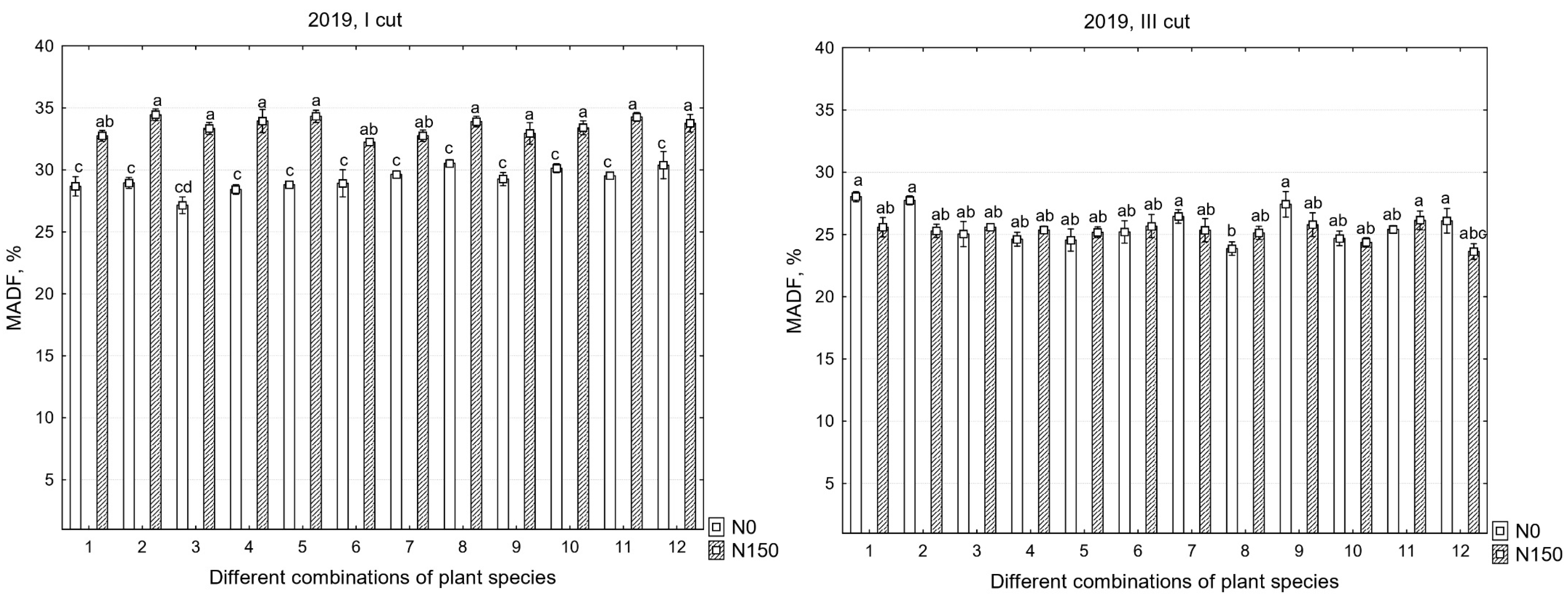
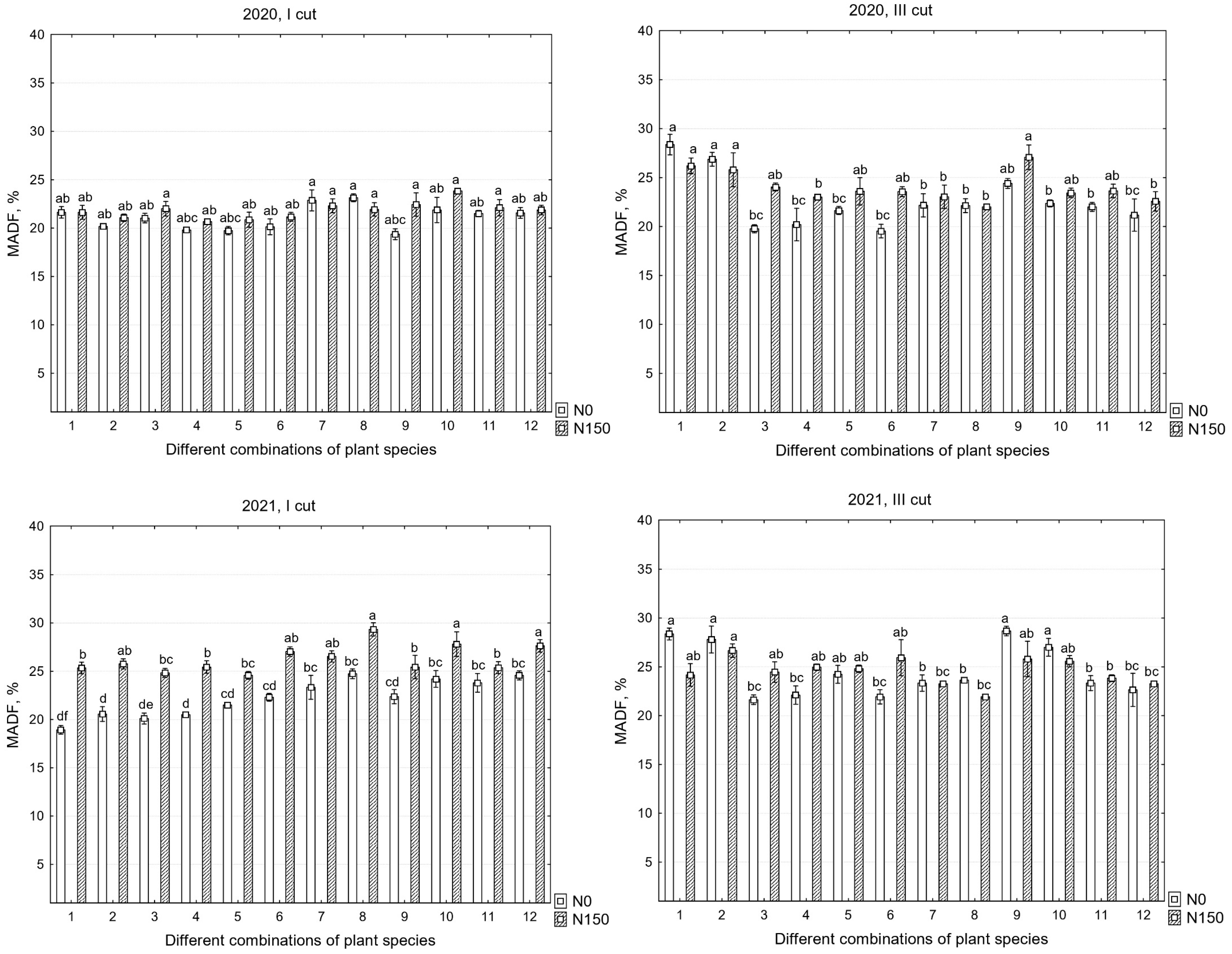
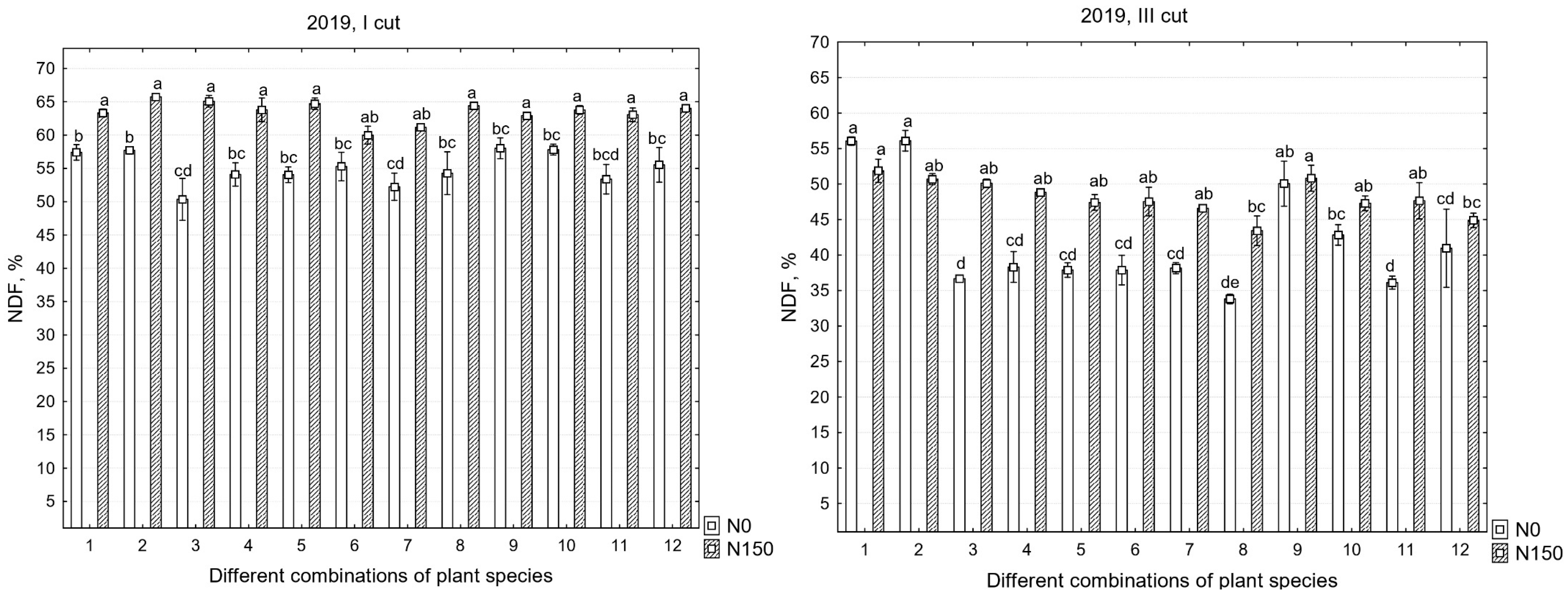
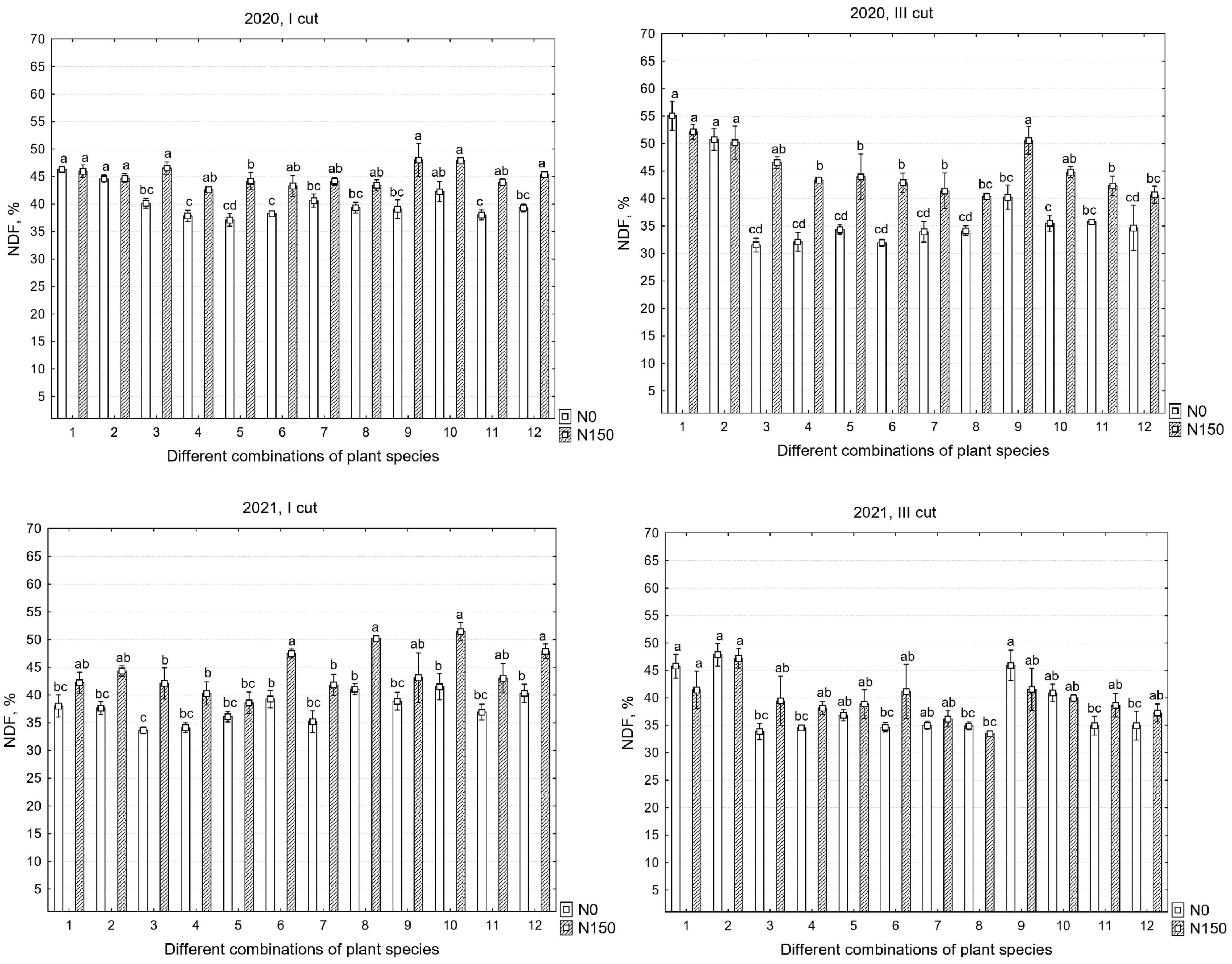
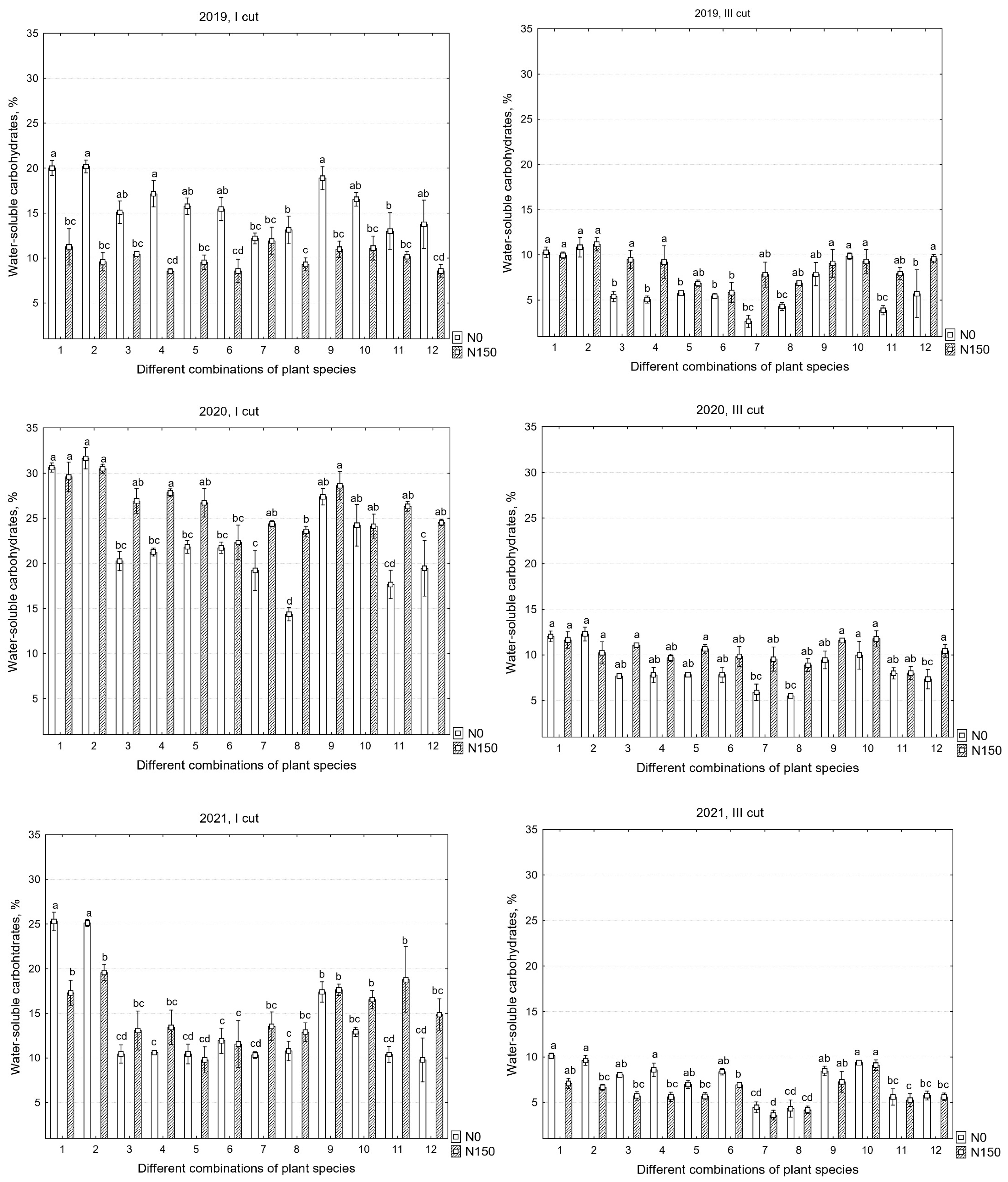

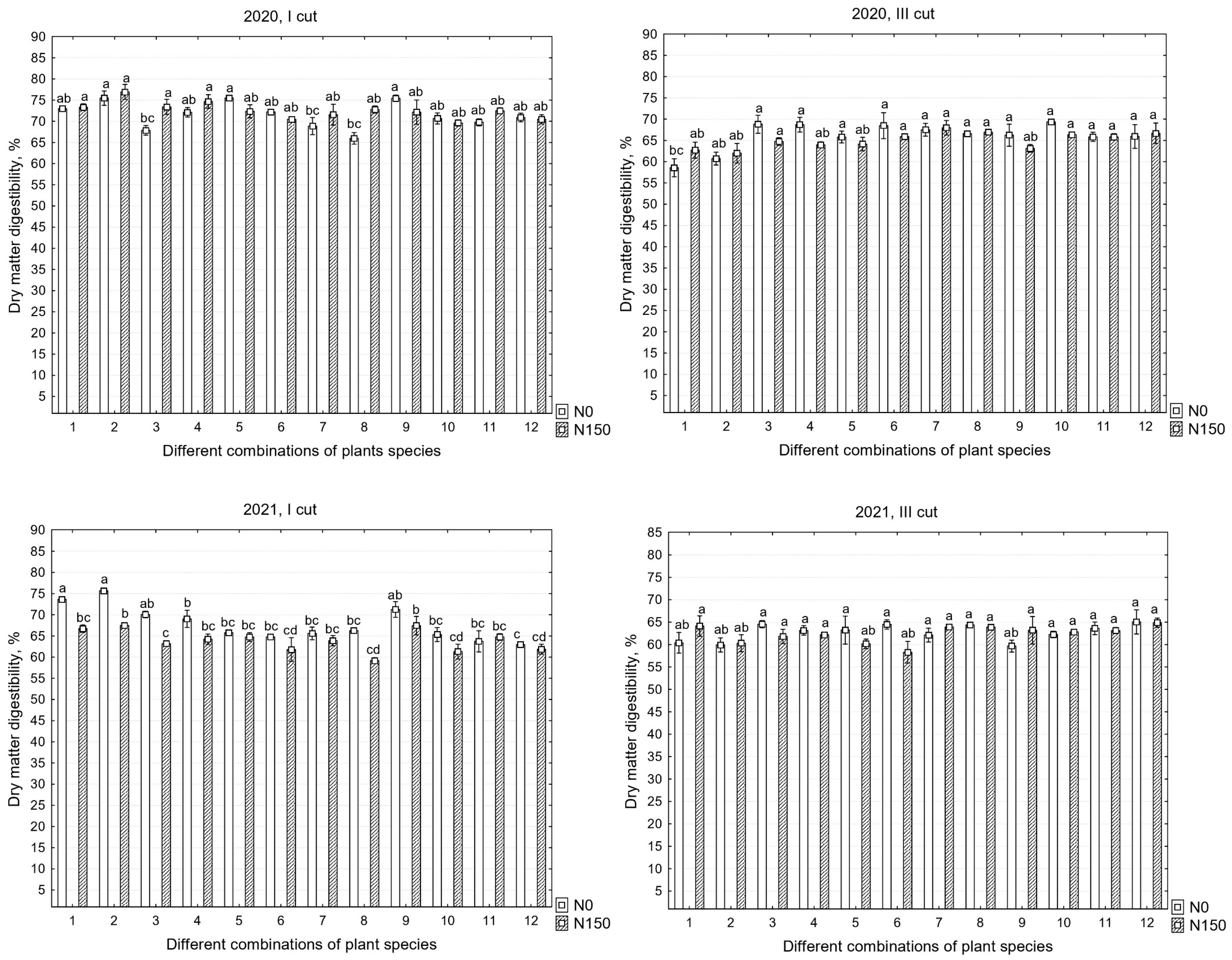
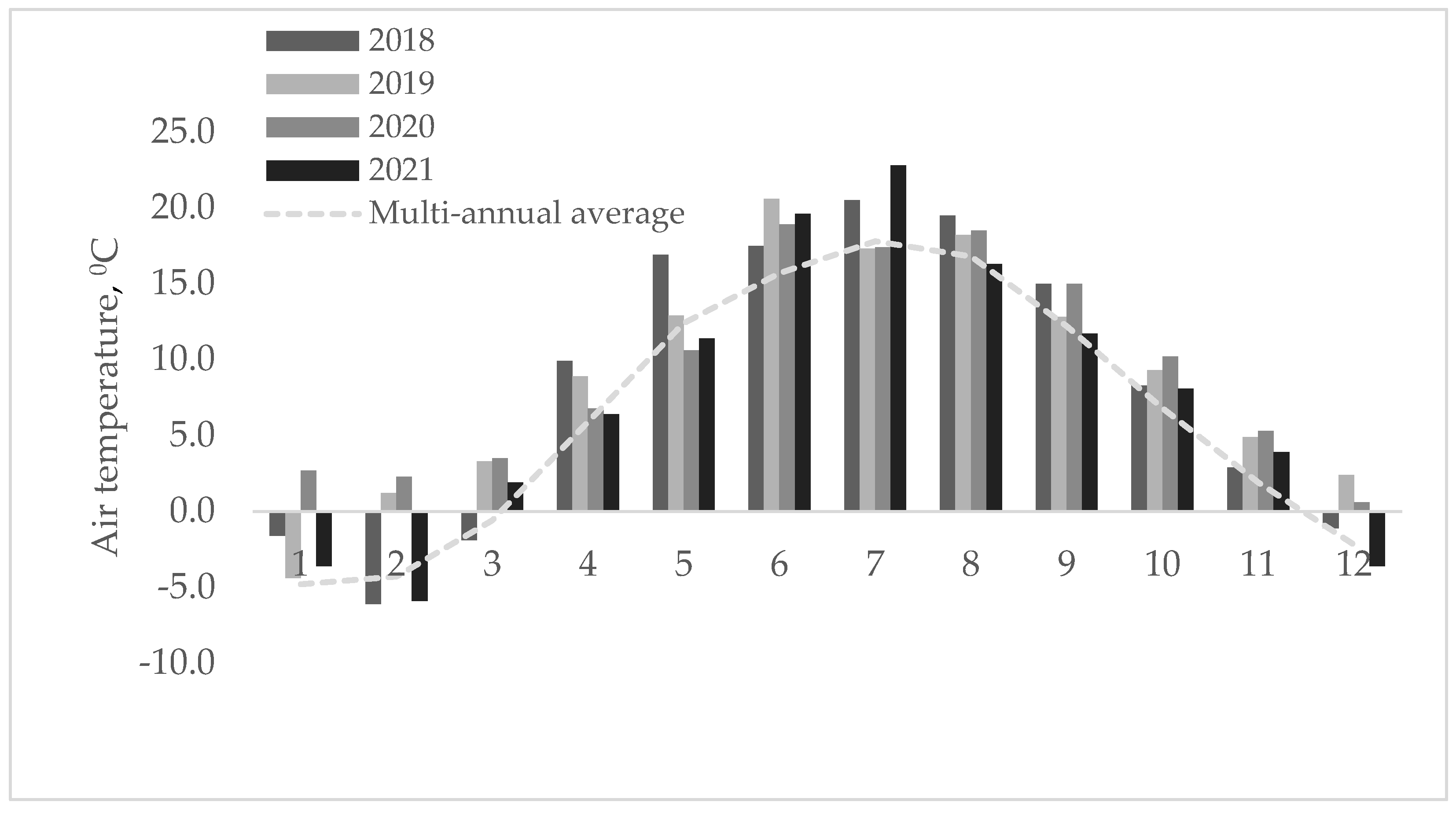
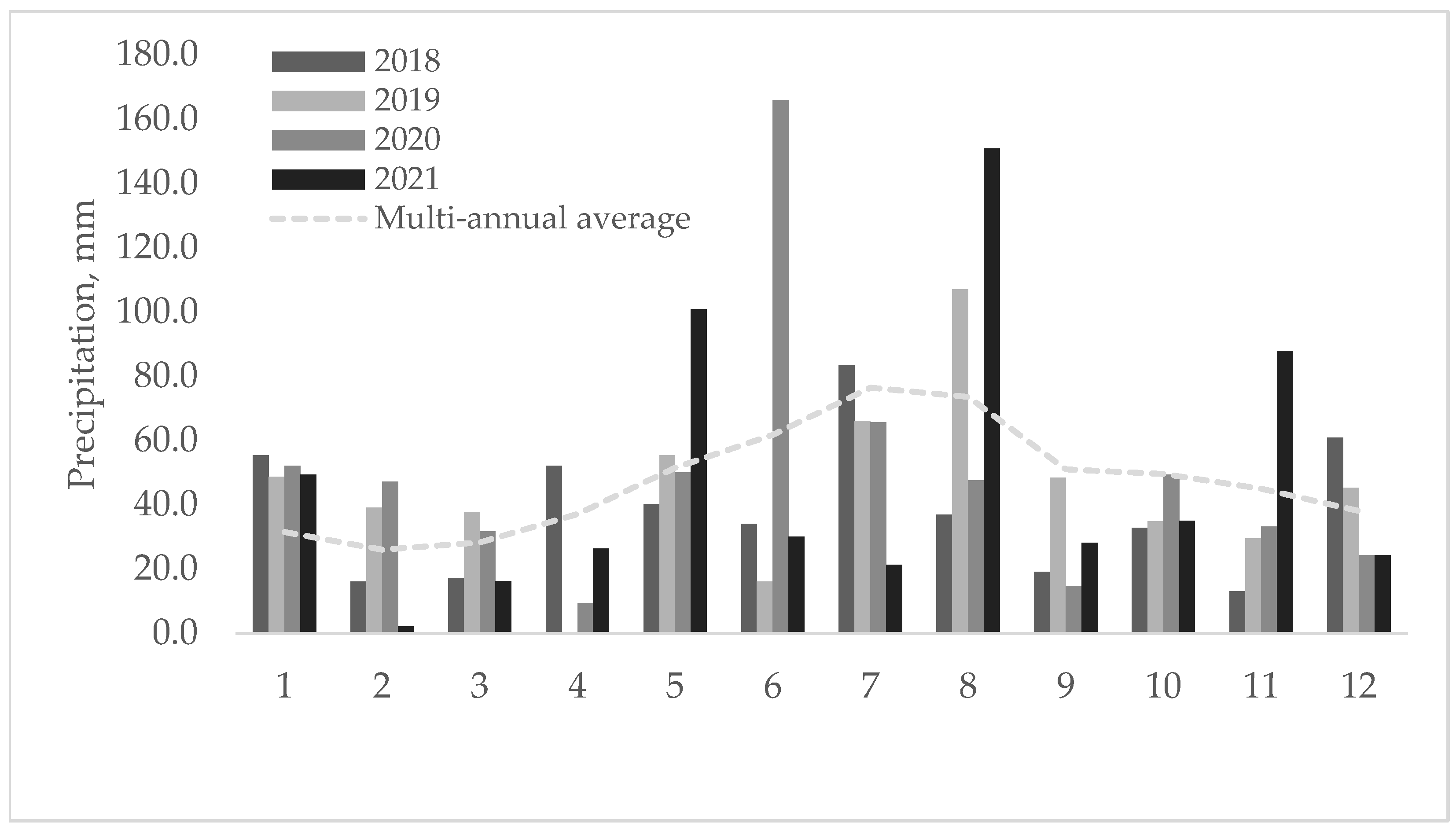
| Year | 2019 | 2020 | 2021 | |||
| Cuts | I | III | I | III | I | III |
| Factor A (grass–legume mixtures) | * | * | * | * | * | * |
| Factor B (fertilization) | ns | * | * | * | * | * |
| Interaction A × B | * | * | * | * | * | ns |
| Year | 2019 | 2020 | 2021 | |||
| Cuts | I | III | I | III | I | III |
| Factor A (grass–legume mixtures) | * | * | * | * | * | * |
| Factor B (fertilization) | * | ns | * | * | * | ns |
| Interaction A × B | ns | * | ns | * | ns | * |
| Year | 2019 | 2020 | 2021 | |||
| Cuts | I | III | I | III | I | III |
| Factor A (grass–legume mixtures) | ns | * | * | * | * | * |
| Factor B (fertilization) | * | * | * | * | * | ns |
| Interaction A × B | ns | * | * | * | ns | ns |
| Year | 2019 | 2020 | 2021 | |||
| Cuts | I | III | I | III | I | III |
| Factor A (grass–legume mixtures) | * | * | * | * | * | * |
| Factor B (fertilization) | * | * | * | * | ns | * |
| Interaction A × B | * | * | * | * | * | * |
| Year | 2019 | 2020 | 2021 | |||
| Cuts | I | III | I | III | I | III |
| Factor A (grass–legume mixtures) | ns | * | * | * | * | ns |
| Factor B (fertilization) | * | * | ns | ns | * | ns |
| Interaction A × B | ns | ns | * | ns | * | ns |
| Treatment | Number of Grass sp. | Number of Legume sp. | Perennial Ryegrass (G1) | ×Festulolium (G2) | Meadow Fescue (G3) | Timothy (G4) | White Clover (L1) | Red Clover (L2) | Lucerne (L3) | Sainfoin (L4) |
|---|---|---|---|---|---|---|---|---|---|---|
| 1 | 1 | 0 | 100 | |||||||
| 2 | 1 | 0 | 100 | |||||||
| 3 | 1 | 2 | 60 | 20 | 20 | |||||
| 4 | 1 | 2 | 60 | 20 | 20 | |||||
| 5 | 2 | 2 | 30 | 30 | 20 | 20 | ||||
| 6 | 4 | 2 | 15 | 15 | 15 | 15 | 20 | 20 | ||
| 7 | 2 | 2 | 30 | 30 | 20 | 20 | ||||
| 8 | 4 | 2 | 15 | 15 | 15 | 15 | 20 | 20 | ||
| 9 | 2 | 2 | 30 | 30 | 20 | 20 | ||||
| 10 | 4 | 2 | 15 | 15 | 15 | 15 | 20 | 20 | ||
| 11 | 2 | 4 | 30 | 30 | 10 | 10 | 10 | 10 | ||
| 12 | 4 | 4 | 15 | 15 | 15 | 15 | 10 | 10 | 10 | 10 |
Disclaimer/Publisher’s Note: The statements, opinions and data contained in all publications are solely those of the individual author(s) and contributor(s) and not of MDPI and/or the editor(s). MDPI and/or the editor(s) disclaim responsibility for any injury to people or property resulting from any ideas, methods, instructions or products referred to in the content. |
© 2023 by the authors. Licensee MDPI, Basel, Switzerland. This article is an open access article distributed under the terms and conditions of the Creative Commons Attribution (CC BY) license (https://creativecommons.org/licenses/by/4.0/).
Share and Cite
Šidlauskaitė, G.; Kadžiulienė, Ž. The Effect of Inorganic Nitrogen Fertilizers on the Quality of Forage Composed of Various Species of Legumes in the Northern Part of a Temperate Climate Zone. Plants 2023, 12, 3676. https://doi.org/10.3390/plants12213676
Šidlauskaitė G, Kadžiulienė Ž. The Effect of Inorganic Nitrogen Fertilizers on the Quality of Forage Composed of Various Species of Legumes in the Northern Part of a Temperate Climate Zone. Plants. 2023; 12(21):3676. https://doi.org/10.3390/plants12213676
Chicago/Turabian StyleŠidlauskaitė, Gintarė, and Žydrė Kadžiulienė. 2023. "The Effect of Inorganic Nitrogen Fertilizers on the Quality of Forage Composed of Various Species of Legumes in the Northern Part of a Temperate Climate Zone" Plants 12, no. 21: 3676. https://doi.org/10.3390/plants12213676
APA StyleŠidlauskaitė, G., & Kadžiulienė, Ž. (2023). The Effect of Inorganic Nitrogen Fertilizers on the Quality of Forage Composed of Various Species of Legumes in the Northern Part of a Temperate Climate Zone. Plants, 12(21), 3676. https://doi.org/10.3390/plants12213676





